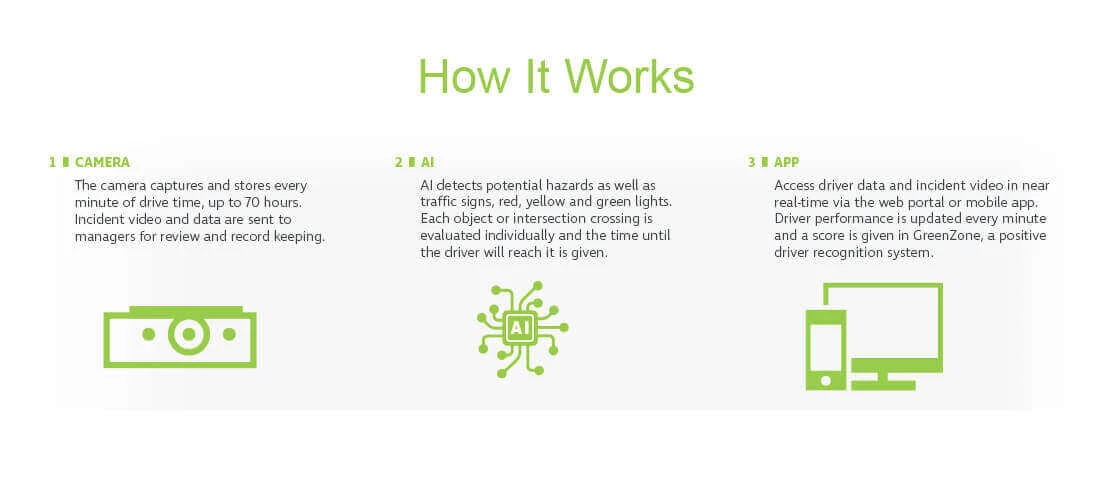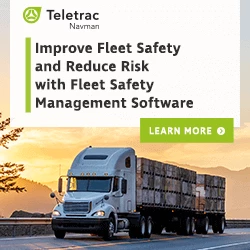The Fleet Dash Cam as an Advanced, Integrated Resource
When selecting a fleet dash cam to connect your vehicles to your telematics hub, you should expect high performance and deep insights from the device and its supporting management software. As part of the quickly growing class of equipment called “Internet of Things,” or IoT, fleet dash cams are data-rich endpoints in your company's fleet network.
Table of contents
- Part of the Internet of Things (IoT) Revolution
- What Telematics + Video Means to Your Fleet Operation
- How a Fleet Dash Cam System Works
- Key Fleet Dash Cam System Features
- AI Fleet Dash Cam
Part of the Internet of Things (IoT) Revolution
Fleet dash cams are IoT enabled devices that form part of your telematics ecosystem, enabling users access to real-time fleet data for fast analysis and timely communication with your vehicle and its operator. Your fleet dash cam should provide the right information, at the right time, and give you significantly increased operational certainty. Key features include fast connectivity and real-time driver communication, imaging resources, sensors and alarms, GPS location, and access to vehicle-specific information. As IoT devices evolve, they are also providing “endpoint data processing,” including artificial intelligence that continually learns to provide new insights through the integration of telematics and video data.
What Telematics + Video Means to Your Fleet Operation
Integrating video insights with telematics data provides businesses with powerful data to help them operate a safe and productive fleet. The integrated technology will provide a wide range of insights including:
- Live video with up to 360-degree coverage
- Live in-cab video and audio
- Continuously updated GPS location data
- ODB-II vehicle network access and information
- Vehicle sensor data such as braking and hazard warning
- Safety and unauthorized access alarms
- DOT required reporting and logging
- On-board data storage for backup and incident analysis
- Messaging capabilities to enhance trip efficiency
- Weather, traffic, and road condition alerts
- Trip data analysis and related scheduling projections
- Fuel cost and supply management
- Smart, actionable data and insights
How a Fleet Dash Cam System Works
Fleet dash cams continually capture high-definition video in real time and save recordings to the cloud when a defined driving event such as speeding, harsh braking, harsh cornering or harsh acceleration occurs. The more advanced dash cams include artificial intelligence that continually learns about drivers and the road. These systems offer more sophisticated driving event triggers such as stop sign violations, red light offences and driver fatigue. A reliable fleet dash cam should always be on, set to record HD video and offer at least 50 hours of video storage. The video recordings for driving events can be viewed in an analytics platform and used alongside driver scorecards as a powerful training tool.

Key Fleet Dash Cam System Features
The best fleet dash cam systems include equipment that offers not only desirable features but solid performance in a heavy-duty environment. You should look out for:
- Hardware that is ruggedized for in-vehicle use including condensation and vibration tolerance.
- High-resolution HD video.
- Built-in audio with noise management or full integration with the vehicle’s audio system.
- Easily readable displays with automatic brightness adjustment for day and night.
- GPS connectivity.
- SD storage for local backup of data relayed to the back office as well as a crash sensor triggered video capture feature.
- Telecom capabilities to link the system independently to the back office via satellite, 4G cellular, and other networks.
- Vehicle integration features that provide access to the ODB-II bus and other vehicle operation and performance data.
- Reliability features in the fleet dash cam that ensure that data is re-sent when needed by the head office software and steps are taken to ensure that clear video is always available, along with other self-tests and redundancies.
AI Fleet Dash Cam
The Future of Fleet Dash Cams Today
The AI capabilities of fleet dash cams will continue to evolve. Today, the most advanced dash cams are already capable of processing high volumes of data and have learning engines enabling them to interpret events and understand the associated risk. AI enabled Fleet dash cams can already measure behaviors including driving without a seatbelt, driving fatigued, driving distracted, stop sign violations and traffic signal violations.
What’s the Best Fleet Dash Cam?
To select the best fleet dash cam for your use, look at the big picture and your company's long-term goals. The device you select now should provide you with the service you need without having to schedule refits for vehicles on-site and on the road when you decide to expand to a more capable unit. The best choice is the unit which supports your company growth, one which is supported by software that has the capability to understand your operations and give you insights and actionable data from that understanding.
Fleet Dash Cams
Most frequently asked questions
While self-install fleet dash cams are available, rugged, tamperproof fleet dash cams require professional installation. These devices can be hardwired into the vehicle’s onboard computer and act as a secondary diagnostic system with built-in accelerometers and GPS. Fleet dash cams should be installed discretely and mounted on the windshield near the rear-view mirror.
Depending on your fleet’s access to wireless cellular networks, the dash cam itself needs relatively little on-device storage. Most fleet dash cams are equipped with wireless LTE or satellite connectivity to store video files on the cloud. On-device storage for fleet dash cams can range from as little as 8 hours to as much as 50 hours on higher-grade cameras.
Our recommendation is to work with your drivers to obtain their consent for installing driver facing cameras. It is also recommended to have a clear policy on when driver-facing footage is captured and how it is used.
Building trust through transparency is the quickest way to get driver buy-in for fleet dash cams. Having a clear policy on what footage is collected and how that footage will be used is crucial. Explaining how the technology works and having training procedures in place will help greatly with driver buy-in.
The dash cam will continue to record but interactive and real-time features will be temporarily suspended until the vehicle is in range of communications systems such as the cellular network. If this is a frequent problem, satellite communications can be used.
Most fleets will need just one dashboard camera per vehicle, however, many fleet dash cams are equipped with 190- to 360-degree views, meaning a single camera can provide forward-facing, side-facing and driver-facing views.
While you may not receive a discount on your commercial auto policy for installing dash cams, insurance companies will use your footage to help determine at-fault incidents and expedite claims, which can save you money in the long term. Dash cams are also helpful in determining negligence and can help exonerate professional drivers.
Fleet dash cams can be customized to record any number of driving events, such as harsh braking, harsh acceleration, harsh cornering, speeding and more. Fleet dash cams with AI technology can also be customized to identify distracted driving. The threshold for when an event is captured is fully customizable and determined by the fleet manager.
Fleet managers can set up real-time alerts in-cab or in the back office to notify drivers and fleet managers of driving incidents or provide warnings of potential incidents. For example, an audible speed warning can be set for in-cab only and a separate alert can be set to alert fleet managers if the behavior persists. Fleet managers can also receive real-time incident reports that can be used for coaching or to provide driver rewards.


